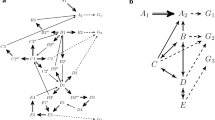Abstract
Medical reasoning in the context of multiple co-existing diseases poses challenges to healthcare professionals by demanding a careful consideration of possible harmful interactions. Computational argumentation, with its conflict resolution capabilities, may assist medical decisions by sorting out these interactions. Unfortunately, most of the argumentation work developed for medical reasoning has not been widely applied to real clinical sources. In this work, we select ASPIC+G and formalise a real clinical case according to the definitions of this argumentation framework. We found limitations in the representation of a patient’s evolution and the formalisation of clinical rules which can be inferred from the context of the clinical case.
Access this chapter
Tax calculation will be finalised at checkout
Purchases are for personal use only
Similar content being viewed by others
Notes
- 1.
s.t.: such that.
- 2.
Here we omit the second index.
References
Costa, R., Neves, J., Novais, P., Machado, J., Lima, L., Alberto, C.: Intelligent mixed reality for the creation of ambient assisted living. In: Neves, J., Santos, M.F., Machado, J.M. (eds.) EPIA 2007. LNCS (LNAI), vol. 4874, pp. 323–331. Springer, Heidelberg (2007). https://doi.org/10.1007/978-3-540-77002-2_27
Cook, D.A., Sherbino, J., Durning, S.J.: Management reasoning: beyond the diagnosis. Jama 319(22), 2267–2268 (2018)
Fraccaro, P., Casteleiro, M.A., Ainsworth, J., Buchan, I.: Adoption of clinical decision support in multimorbidity: a systematic review. JMIR Med. Inform. 3(1), e4 (2015)
Sutton, D.R., Fox, J.: The syntax and semantics of the pro forma guideline modeling language. J. Am. Med. Inform. Assoc. 10(5), 433–443 (2003)
Oliveira, T., Dauphin, J., Satoh, K., Tsumoto, S., Novais, P.: Goal-driven structured argumentation for patient management in a multimorbidity setting. In: Dastani, M., Dong, H., van der Torre, L. (eds.) CLAR 2020. LNCS (LNAI), vol. 12061, pp. 166–183. Springer, Cham (2020). https://doi.org/10.1007/978-3-030-44638-3_11
Johnson, A.E.W., et al.: Mimic-iii, a freely accessible critical care database. Sci. Data 3(1), 160035 (2016). https://doi.org/10.1038/sdata.2016.35
Grando, M.A., Glasspool, D., Boxwala, A.: Argumentation logic for the flexible enactment of goal-based medical guidelines. J. Biomed. Inform. 45(5), 938–949 (2012)
Hunter, A., Williams, M.: Aggregating evidence about the positive and negative effects of treatments. Artif. Intell. Med. 56(3), 173–190 (2012)
Kokciyan, N., et al.: Towards an argumentation system for supporting patients in self-managing their chronic conditions. In: Workshops at the Thirty-Second AAAI Conference on Artificial Intelligence (2018)
Modgil, S., Prakken, H.: The ASPIC+ framework for structured argumentation: a tutorial. Argument Comput. 5, 31–62 (2014)
Carneiro, D., Novais, P., Pêgo, J.M., Sousa, N., Neves, J.: Using mouse dynamics to assess stress during online exams. In: Onieva, E., Santos, I., Osaba, E., Quintián, H., Corchado, E. (eds.) HAIS 2015. LNCS (LNAI), vol. 9121, pp. 345–356. Springer, Cham (2015). https://doi.org/10.1007/978-3-319-19644-2_29
Acknowledgments
This work has been supported by FCT - Fundação para a Ciência e a Tecnologia within the R&D Units project scope UIDB/00319/2020. The work of Ana Silva is also supported by a Portuguese doctoral grant, SFRH/BD/143512/2019, issued by FCT in Portugal.
Author information
Authors and Affiliations
Corresponding author
Editor information
Editors and Affiliations
Rights and permissions
Copyright information
© 2020 Springer Nature Switzerland AG
About this paper
Cite this paper
Silva, A., Silva, A., Oliveira, T., Novais, P. (2020). Mapping a Clinical Case Description to an Argumentation Framework: A Preliminary Assessment. In: Analide, C., Novais, P., Camacho, D., Yin, H. (eds) Intelligent Data Engineering and Automated Learning – IDEAL 2020. IDEAL 2020. Lecture Notes in Computer Science(), vol 12489. Springer, Cham. https://doi.org/10.1007/978-3-030-62362-3_30
Download citation
DOI: https://doi.org/10.1007/978-3-030-62362-3_30
Published:
Publisher Name: Springer, Cham
Print ISBN: 978-3-030-62361-6
Online ISBN: 978-3-030-62362-3
eBook Packages: Computer ScienceComputer Science (R0)




